The Delta Variant
John Landis’s 1978 comedy classic ‘Animal House’ is a time capsule from an era when humor and campus politics were very different.

John Landis’s 1978 comedy classic ‘Animal House’ is a time capsule from an era when humor and campus politics were very different.





Join the newsletter to receive the latest updates in your inbox.